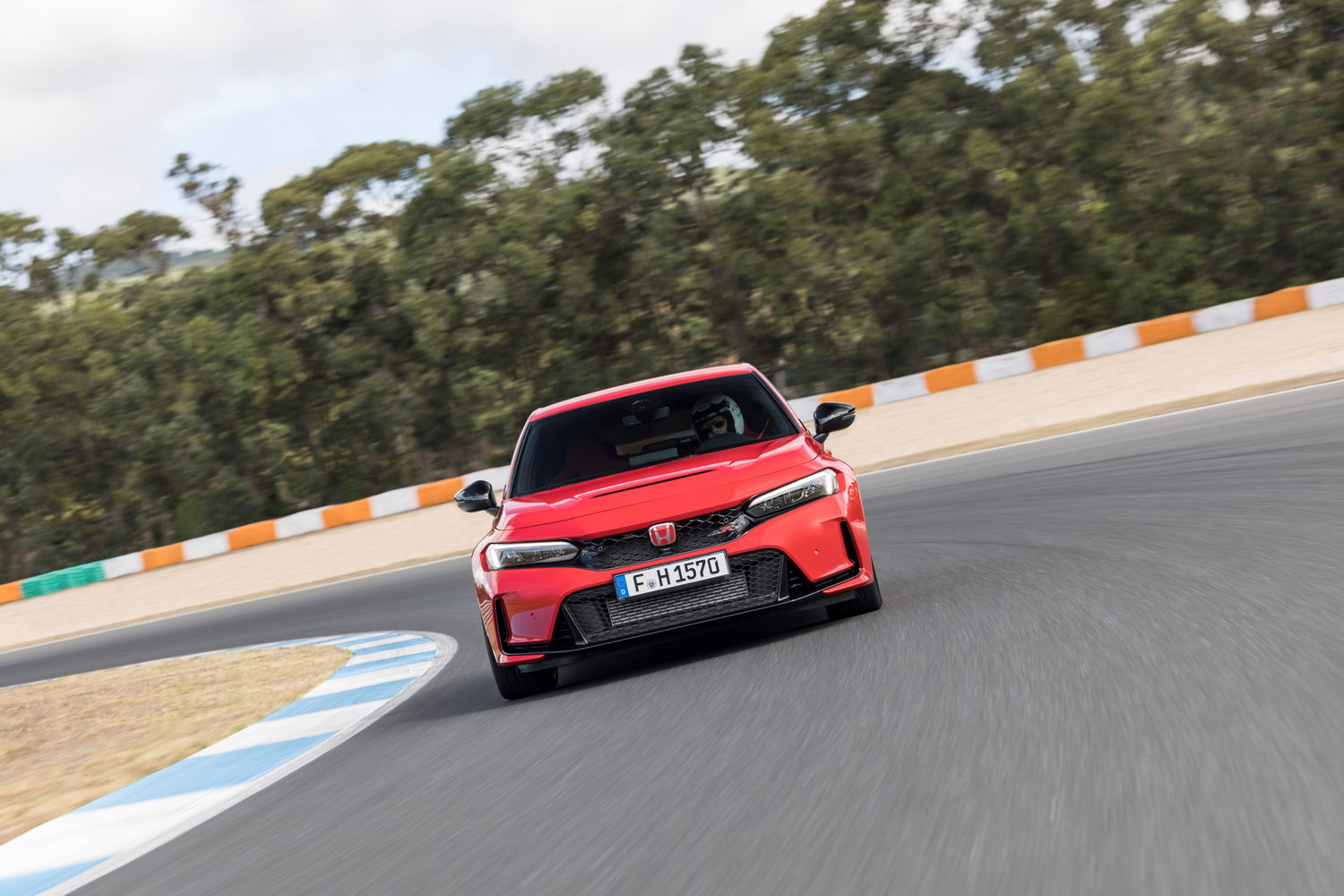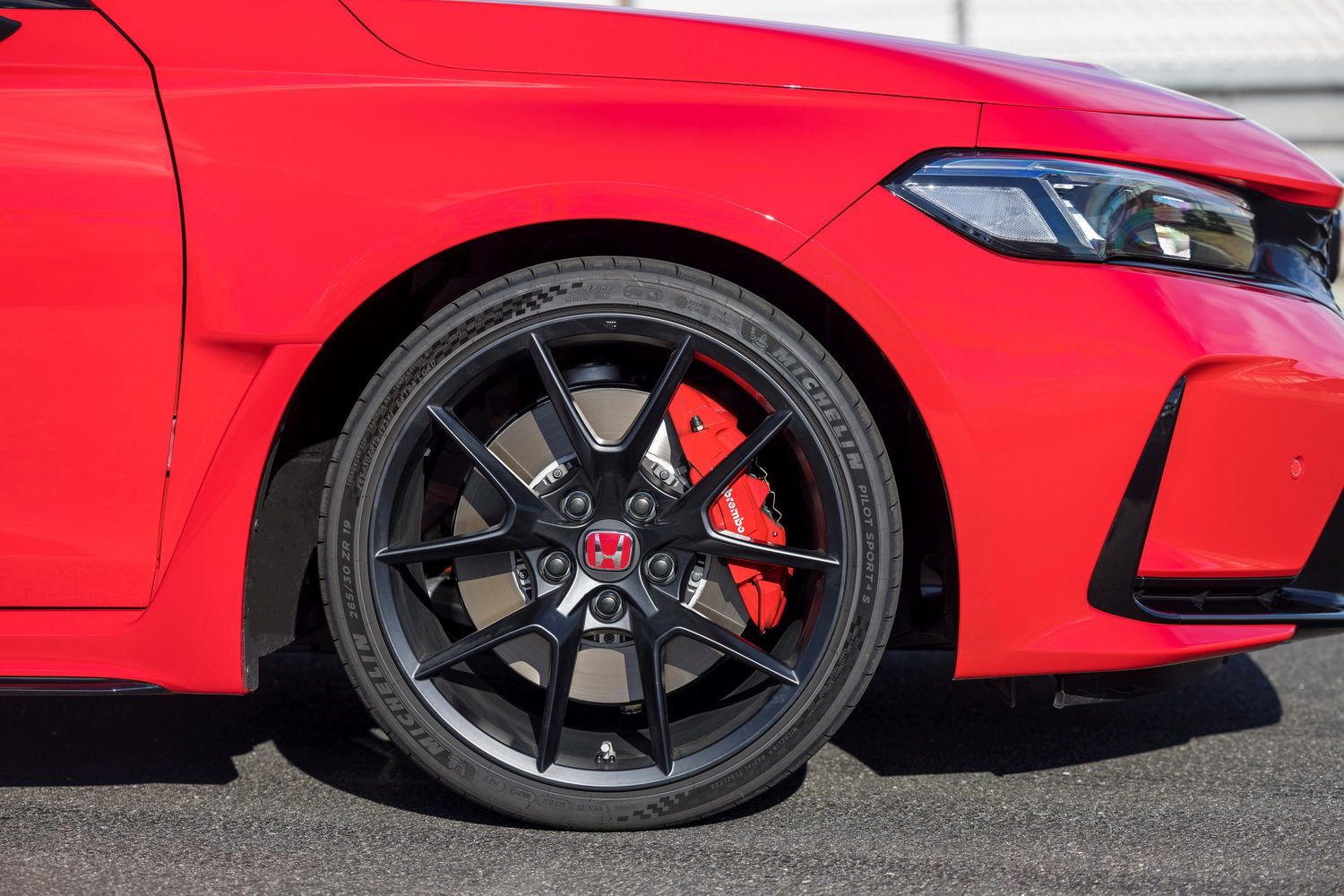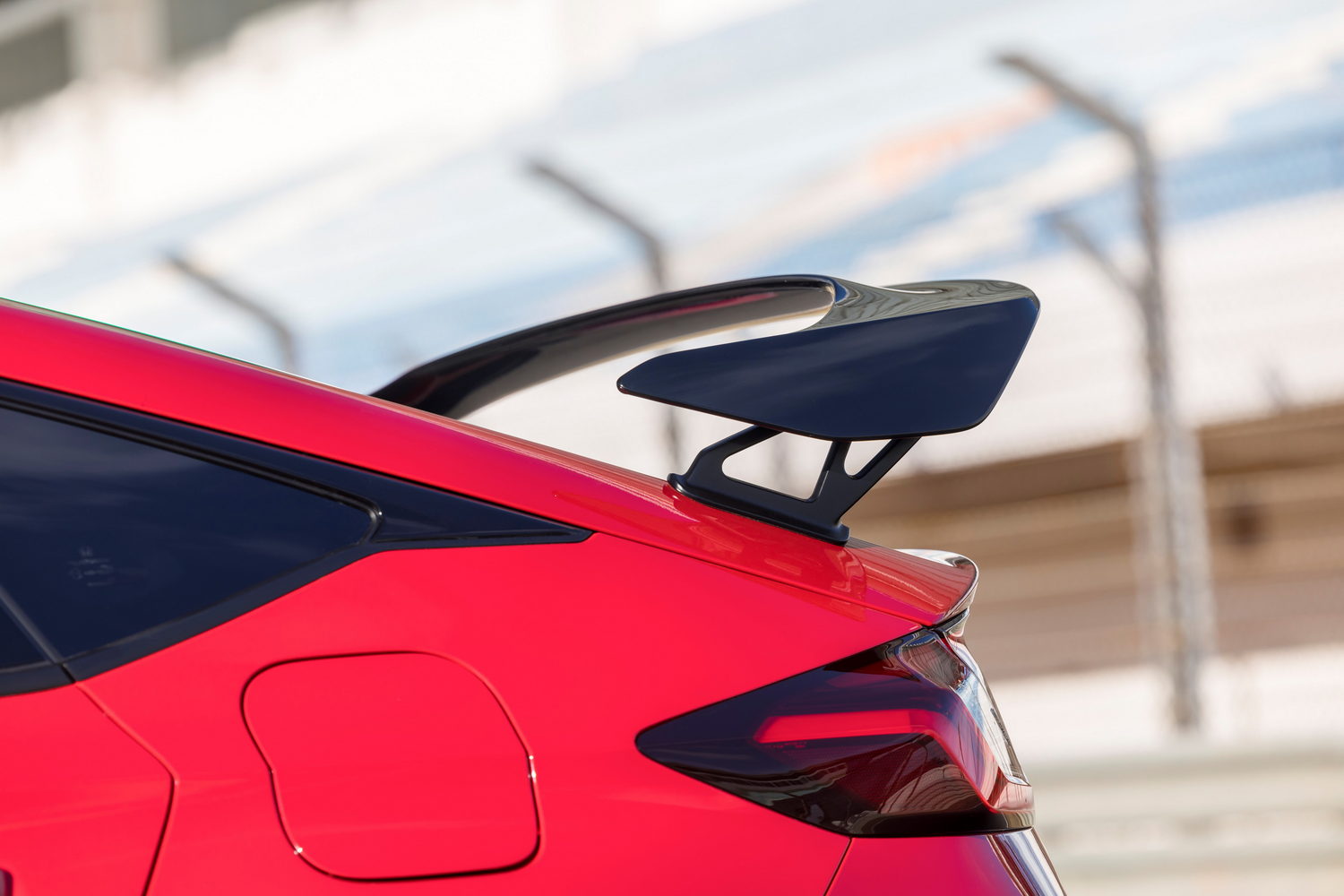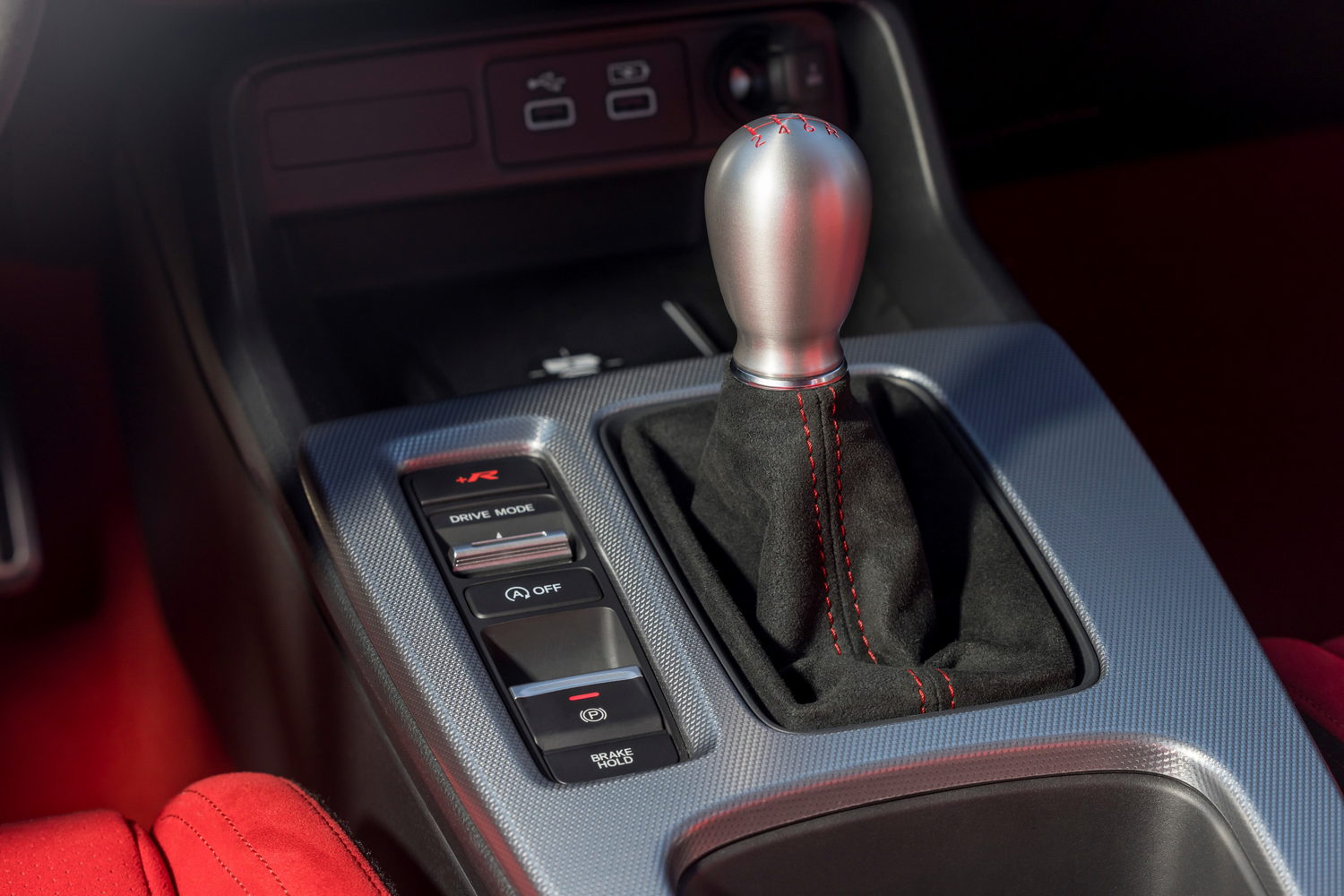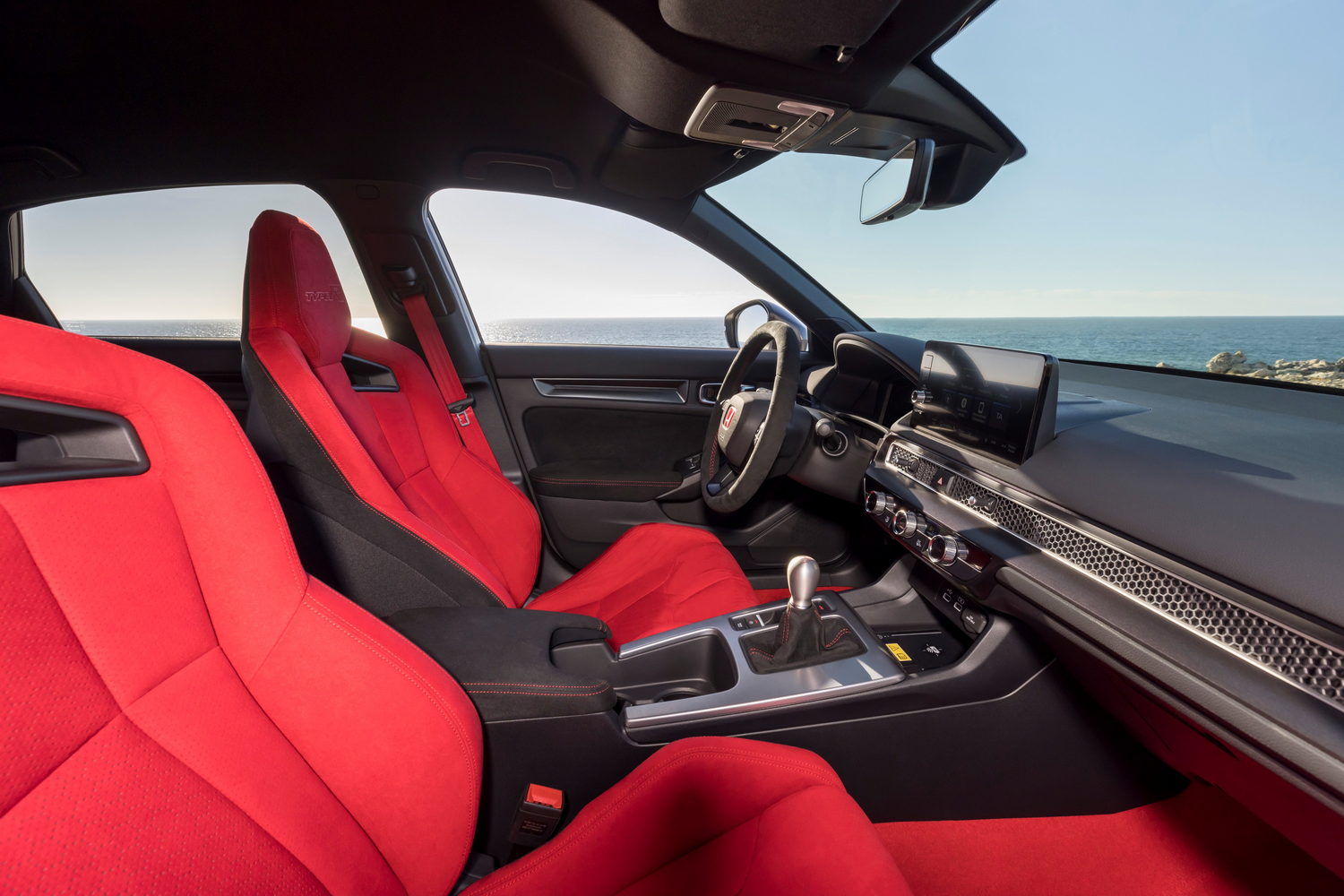The new Honda Civic has already impressed us in its conventional, family-friendly e:HEV hybrid form, but the Japanese company is not resting on its laurels. Hot on the heels of the economical e:HEV is the much less economical, yet much more exciting Type R. The hybrid powertrain is gone, replaced with a much more potent turbocharged petrol engine, while the bodywork, interior and underpinnings have all been heavily upgraded. Is the resulting hot hatchback an improvement on its predecessor?
In the metal
By using the latest-generation Honda Civic e:HEV as a base, the new Type R had something of a head start on its predecessor in the looks department. The basic shape is a little less angular and noticeably more modern, giving it a more contemporary look. But in classic Type R style, Honda had to add some performance-orientated tweaks that make the Type R stand out from the crowd.
The Japanese company claims the changes are primarily made with downforce in mind, and the engineers reckon they have reduced the car's lift coefficient with new bumpers, the massive rear wing and a slot in the bonnet. That may all be the case, but it seems hard to believe aesthetic considerations weren't also part of the plan. The triple-exit exhaust, chunky side sills and upgraded bumpers all seem to be built as much for dramatic effect as for aerodynamics. The resulting car certainly stands out in a crowd, even alongside some more grown-up hot hatchbacks.
It's a similar story inside, where the basic Civic structure has been garnished with plenty of motorsport-inspired features to give it a completely different character. As with the external design, the Type R cabin builds on strong foundations, with a dashboard that's more premium and more high-tech than that of the old Civic, with smarter materials and the same trademark Japanese build quality.
The most obvious new feature is the upholstery, which sees the bucket seats trimmed in red suede, while the colour also features on the carpets. Team that with the brushed metal gear knob and the serial number on the dashboard and you've got a car that instantly feels more special than a conventional Civic e:HEV.
Naturally, the Type R inherits some of the standard Civic's technology, which is a mixed blessing, but it's a marked improvement on what went before. The nine-inch touchscreen still looks a bit dated and it's still a bit slow to respond, but it's much more modern than the old system and it comes with plenty of standard features, including navigation, a reversing camera and the Apple CarPlay and Android Auto smartphone integration tech, which owners are expected to use most of the time anyway. That's combined with a new digital instrument cluster, which falls into much the same category as the touchscreen. It looks dated alongside the systems found in rival cars - the graphics are still a bit too similar to those of an old racing video game for our liking - but it does the job well enough.
And it has plenty to do, thanks to the on-board telemetry technology Honda has added to the Type R. That doesn't just allow customers to record G-readings and lap times, but it can monitor details such as driver inputs and vehicle responses, allowing the system to score drivers and help them improve their lap times on a racetrack. The system even incorporates a digital tyre friction value, which displays the maximum tyre friction force each of the four tyres can exert at a given moment, as well as the value of both longitudinal and lateral tyre force being used, showing drivers how close they are to the limits of grip.
But for all this computer game tech, the Civic still has to offer some practicality. Here, the new platform provides a small chink in the Honda's armour, with a slightly smaller boot than the old car. Apparently, that's a hangover from the hybrid system fitted to the standard car, the boot floor of which has been transferred to the distinctly hybrid-free Type R. Still, a drop in volume from 420- to 410 litres is barely noticeable, and it still leaves the Honda ahead of many rivals in terms of luggage space.
In the cabin, front space is more than adequate, although the seats are a little too hard for it to be properly comfortable on long drives, while visibility for the driver is slightly better than before, despite the driver sitting 8mm lower than in the basic Civic. More good news comes from the rear, where two adults should have no great difficulty slotting into the back seats, despite the sloping roofline - and legroom is adequate. That said, the big bucket seats in the front limit forward visibility for rear passengers, and the rear cabin can feel a little bit dark.
Driving it
Like the standard Civic, the Type R is a front-wheel-drive hatchback with a 2.0-litre petrol engine, but there the similarities between the powertrains end. Whereas the basic Civic has a complicated hybrid system, the Type R simply uses Honda's VTEC valve timing technology and a redesigned turbocharger to produce up to 329hp and 420Nm of torque. All of which goes through a honed six-speed manual gearbox before arriving at the front wheels.
The recipe is, perhaps surprisingly, much as it was before, but Honda has fine-tuned the details to up the performance slightly. The exhaust flows a little more freely, while the intake can suck more air in than before. The result is impressive - the Civic gets from 0-100km/h in 5.4 seconds and flat out it can do 275km/h where allowed. Admittedly, the acceleration looks a bit sluggish alongside all-wheel-drive, automatic rivals such as the VW Golf R, but not excessively so, and it's faster than front-drive, manual hatchbacks such as the standard Golf GTI.
What's more disappointing is the engine note, which is decidedly subdued in Comfort mode. That isn't necessarily a bad thing - nobody wants childish exhaust pops and bangs all the time - but it doesn't get much more raucous when you swap the Comfort setting for the Sport or +R modes.
That said, the gearbox is brilliant, with slick, intuitive shifts and a rev-matching system to help make your downshifts smoother and more consistent. It's quicker and easier than doing it yourself, especially if you aren't quite up to racing legend standards when it comes to heel-and-toe braking.
Everyone will be able to appreciate the way the Civic Type R drives, though. Again, it started from a good place with the new Civic hatchback, so the longer wheelbase and new rear suspension were already in place. But Honda has added a wider track for the Type R and new logic for the electric power steering system, all with the aim of increasing cornering stability. There are new, specially designed Michelin tyres, too, giving the car a bit more grip.
As a result, the new Type R feels more agile than its predecessor, albeit only fractionally. Grip is mountainous, even in the wet, and the car never seems to have any trouble putting the power down, despite only powering the front wheels. Body control is great and there's adequate feedback, which lets you know what the car is up to at any given moment. Add in the quality of the gearbox and the sharp throttle responses, and you've got a really enjoyable car to drive quickly - perhaps more so than a Golf R or an Audi S3.
But what really impresses is not the Civic's ability to light up racetrack timing screens, or its ability to draw a crowd at a car meet. Instead, it's the comparative comfort of the ride. In the past, Type Rs have been excessively firm - just ask any owners of the old 'FK2' model - but the new car is significantly more comfortable. You can still feel the stiffness in the chassis, but in Comfort mode it's really easy to live with, and the biggest problems on a long journey will be the seats and the refinement, with lots of road noise seeping into the cabin. But the suspension won't be an issue unless you put it in Sport mode, at which point it'll pick out imperfections in the road surface where you thought there were none. On bad roads - and there are plenty of those - the more aggressive driving modes are borderline intolerable. Thankfully the new Comfort setting makes the car a joy on all.
What you get for your money
Honda is yet to confirm Irish prices for the new Civic Type R, but we'll be sure to update this section when we know more. What we do know is that the new hot hatch is likely to be considerably more expensive than the existing Civic e:HEV, which is on sale from around €34,000.
Summary
The new Type R carries on where the old car left off. Those who own its predecessor can rest assured the new model isn't a quantum leap forward in terms of driving dynamics, but it is an improvement in lots of ways. It's smarter inside and build quality has improved, as has the on-board technology. In short, it's the best Honda Civic Type R we've seen in more than a decade, and that's quite some accolade.










